VBQs Mathematical Reasoning Class 11 Mathematics with solutions has been provided below for standard students. We have provided chapter wise VBQ for Class 11 Mathematics with solutions. The following Mathematical Reasoning Class 11 Mathematics value based questions with answers will come in your exams. Students should understand the concepts and learn the solved cased based VBQs provided below. This will help you to get better marks in class 11 examinations.
Mathematical Reasoning VBQs Class 11 Mathematics
Question. The statement “If x2 is not even, then x is not even” is converse of the statement
(a) If x2 is odd, then x is even
(b) If x is not even, then x2 is not even
(c) If x is even, then x2 is even
(d) If x is odd, then x2 is even
Answer
B
Question. Which of the following is a statement?
(a) Everyone in this room is bold
(b) She is an engineering student
(c) sin2θ is greater than 1/2
(d) Three plus three equals six
Answer
D
Question. ~ (p ∨ (~ p)) is equal to
(a) ~ p ∨ q
(b) (~ p) ∧ q
(c) ~ p ∨ ~ p
(d) ~ p ∧ ~ p
Answer
B
Question. The negation of the statement:
“A circle is an ellipse” is
(a) An ellipse is a circle.
(b) An ellipse is not a circle.
(c) A circle is not an ellipse.
(d) A circle is an ellipse.
Answer
C
Question. Let p: Kiran passed the examination,
q: Kiran is sad
The symbolic form of a statement “It is not true that Kiran passed therefore he is said” is
(a) (~ p → q)
(b) (p → q)
(c) ~ (p → ~ q)
(d) ~ ( p ↔ q)
Answer
B
Question. Which of the following is not a statement?
(a) 2 is an even integer.
(b) 2 + 1= 3.
(c) The number 17 is prime.
(d) x + 3 = 10, x ∈ R.
Answer
D
Question. Which of the following is the conditional p → q?
(a) q is sufficient for p
(b) p is necessary for q
(c) p only if q
(d) if q, then p
Answer
C
Question. Which of the following is true?
(a) p ∧ ~ p ≡ T
(b) p ∨ ~ p ≡ F
(c) p → q ≡ q → p
(d) p → q ≡ (~q) → (~p)
Answer
D
Question. Which of the following statement is a conjunction?
(a) Ram and Shyam are friends.
(b) Both Ram and Shyam are tall.
(c) Both Ram and Shyam are enemies.
(d) None of the above.
Answer
D
Question. p ⇒ q can also be written as
(a) p ⇒ ~ q
(b) ~ p ∨ q
(c) ~ q ⇒ ~ p
(d) None of these
Answer
B
Question. Which of the following is a statement?
(a) May you live long!
(b) May God bless you!
(c) The sun is a star.
(d) Hurrah! we have won the match.
Answer
C
Question. Which of the following is an open statement?
(a) Good morning to all
(b) Please do me a favour
(c) Give me a glass of water
(d) x is a natural number
Answer
D
Question. “Paris is in England” is a _________
(a) statement
(b) sentence
(c) both ‘a’ and ‘b’
(d) neither ‘a’ nor ‘b’
Answer
A
Question. Which of the following is/are connectives?
(a) Today
(b) Yesterday
(c) Tomorrow
(d) “And”, “or”
Answer
D
Question. If p, q, r are statement with truth vales F, T, F respectively, then the truth value of p→(q →r) is
(a) false
(b) true
(c) true if p is true
(d) none
Answer
B
Question. “The sun is a star” is a __________
(a) statement
(b) sentence
(c) both ‘a’ and ‘b’
(d) neither ‘a’ nor ‘b’
Answer
C
Question. Consider the following statements
p : x, y ∈ Z such that x and y are odd.
q : xy is odd. Then,
(a) p ⇒ q is true
(b) ~ q ⇒ p is true
(c) Both (a) and (b)
(d) None of these
Answer
A
Question. Which of the following is the converse of the statement? “If Billu secure good marks, then he will get a bicycle.”
(a) If Billu will not get bicycle, then he will not secure good marks.
(b) If Billu will get a bicycle, then he will secure good marks.
(c) If Billu will get a bicycle, then he will not secure good marks.
(d) If Billu will not get a bicycle, then he will secure good marks.
Answer
B
Question. If (p ∧ ~ r) ⇒ (q ∨ r) is false and q and r are both false, then p is
(a) True
(b) False
(c) May be true or false
(d) Data insufficient
Answer
A
Question. The contrapositive of the statement, ‘ If I do not secure good marks then I cannot go for engineering’, is
(a) If I secure good marks, then I go for engineering.
(b) If I go for engineering then I secure good marks.
(c) If I cannot go for engineering then I donot secure good marks.
(d) None.
Answer
B
Question. Which of the following is a statement?
(a) x is a real number
(b) Switch off the fan
(c) 6 is a natural number
(d) Let me go
Answer
C
Question. Which of the following is true?
(a) p ⇒ q ≡ ~ p⇒ ~ q
(b) ~ (p ⇒ ~ q) ≡ ~ p ∧ q
(c) ~ (~ p ⇒ ~ q) ≡ ~ p ∧ q
(d) ~ (~ p ⇔ q) ≡ [~ (p ⇒ q)∧ ~ (q ⇒ p)]
Answer
C
Question. A compound statement p or q is false only when
(a) p is false
(b) q is false
(c) both p and q are false
(d) depends on p and q
Answer
C
Question. If ~q ∨ p is F, then which of the following is correct?
(a) p ↔ q is T
(b) p → q is T
(c) q → p is T
(d) p → q is F
Answer
B
Question. If Ram secures 100 marks in maths, then he will get a mobile. The converse is
(a) If Ram gets a mobile, then he will not secure 100 marks
(b) If Ram does not get a mobile, then he will secure 100 marks
(c) If Ram will get a mobile, then he secures 100 marks in maths
(d) None of these
Answer
C
STATEMENT TYPE QUESTIONS
Question. Consider the following statements
I. “Every rectangle is a square” is a statement.
II. “Close the door” is not a statement.
Choose the correct option.
(a) Only I is false.
(b) Only II is false.
(c) Both are true.
(d) Both are false.
Answer
C
Question. Consider the following statements
Statement-I: The negation of the statement “The number 2 is greater than 7” is “The number 2 is not greater than 7”.
Statement-II: The negation of the statement “Every natural number is an integer” is “every natural number is not an integer”.
Choose the correct option.
(a) Only Statement I is true
(b) Only Statement II is true
(c) Both Statement are true
(d) Both Statement are false
Answer
C
Question. If p → q is a conditional statement, then its
I. Converse : q → p
II. Contrapositive : ~ q → ~p
III. Inverse : ~ p → ~ q
Choose the correct option.
(a) Only I and II are true.
(b) Only II and III are true.
(c) Only I and III are true.
(d) All I, II and III are true.
Answer
D
Question. Consider the following statements.
I. x + y = y + x is true for every real numbers x and y.
II. There exists real numbers x and y for which x + y = y + x.
Choose the correct option.
(a) I and II are the negation of each other.
(b) I and II are not the negation of each other.
(c) I and II are the contrapositive of each other.
(d) I is the converse of II.
Answer
B
Question. Consider the following statements.
I. A sentence is called a statement, if it is either true or false.
II. The sentence, “Today is a windy day”, is not a statement.
Choose the correct option.
(a) Both I and II are true.
(b) Only I is true.
(c) Only II is true.
(d) Both I and II are false.
Answer
A
Question. Consider the following statements.
I. If a number is divisible by 10, then it is divisible by 5.
II. If a number is divisible by 5, then it is divisible by 10.
Choose the correct option.
(a) I is converse of II.
(b) II is converse of I.
(c) I is not converse of II.
(d) Both ‘a’ and ‘b’ are true.
Answer
D
Question. Read the following statements.
Statement: If x is a prime number, then x is odd.
I. Contrapositive form : If a number x is not odd, then x is not a prime number.
II. Converse form : If a number x is odd, then it is a prime number.
Choose the correct option.
(a) Both I and II are true.
(b) Only I is true.
(c) Only II is true.
(d) Neither I nor II true.
Answer
A
Question. (a) a ∧ a =1
(b) a ∧ a = a
(c) a ∧ a = 0
(d) None of these
Answer
B
Question. Which of the following is always true?
(a) ( p⇒q) ≡ ~ q⇒~ p
(b) ~ ( p ∨ q) ≡ ∨ p ∨ ~ q
(c) ~ ( p⇒q) ≡ p ∧ ~ q
(d) ~ ( p ∨ q) ≡ ~ p ∧ ~ q
Answer
C
Question. The logically equivalent proposition of p⇔ q is:
(a) ( p ∧ q) ∨ ( p ∧ q)
(b) ( p⇒q) ∧ (q⇒ p)
(c) ( p ∧ q)∨ (q⇒ p)
(d) ( p ∧ q)⇒(q ∨ p)
Answer
B
Question. (a) a ∨1 = a
(b) a ∨1 =1
(c) a ∨1 = 0
(d) None of these
Answer
B
Question. (a) a ∨ a′ = 0
(b) a ∨ a′ =1
(c) a ∨ a′ = a
(d) None of these
Answer
B
Question. Negation of the conditional: “If it rains, I shall go to school” is?
(a) It rains and I shall go to school
(b) It rains and I shall not go to school
(c) It does not rains and I shall go to school
(d) None of these
Answer
B
Question. Negation of “Paris in France and London is in England” is?
(a) Paris is in England and London is in France
(b) Paris is not in France or London is not in England
(c) Paris is in England or London is in France
(d) None of these
Answer
B
Question. (a) a ∧ a′ =1
(b) a ∧ a′ = 0
(c) a ∧ a′ = a
(d) None of these
Answer
B
Question. (a) 0′ = 0
(b) 0′ =1
(c) 1′ =1
(d) None of these
Answer
B
Question. (a) (a ∨ b)′ = a′∨ b′
(b) (a ∨ b)′ = a′∧b′
(c) (a ∨ b)′∨ a ∨ b
(d) None of these
Answer
B
Question. (a) (a ∧b)′ = a′∨ b′
(b) (a ∧b)′ = a′∧b′
(c) (a ∧b)′ = a ∨ b
(d) None of these
Answer
A
Question. (a) a ∨ (a ∧ b) = a
(b) a ∨ (a ∧ b) = b
(c) a ∨ (a ∧b) = a ∨ b
(d) None of these
Answer
A
Question. Which of the following is a statement?
(a) Open the door
(b) Do your homework
(c) Switch on the fan
(d) Two plus two is four
Answer
D
Question. Which of the following is a statement?
(a) May you live long!
(b) May God bless you!
(c) The sun is a star
(d) Hurrah! we have won the match
Answer
C
Question. (a) a ∧ (a ∨ b) = b
(b) a ∧ (a ∨ b) = a
(c) a ∧ (a ∨ b) = 0
(d) None of these
Answer
B
Question. (a) x ∨ x′ x = x′
(b) x ∨ x′ x = x
(c) x ∨ x′ x =1
(d) None of these
Answer
B
Question. (a) x ∨ x′y = x
(b) x ∨ x′y = y
(c) x ∨ x′y = x ∨ y
(d) None of these
Answer
C
Question. (a) x ∧ (x ∨ y) = x
(b) x ∧ (x ∨ y) = y
(c) x ∧ (x ∨ y) =1
(d) None of these
Answer
A
Question. Negation of the proposition: If we control population growth, we prosper:
(a) If we do not control population growth, we prosper
(b) It we control population growth, we do not prosper
(c) We control population but we do not prosper
(d) We do not control population, but we prosper
Answer
C
Question. Which Venn diagram represent the truth of the statement “All smokers are drinkers and all drinkers are smokers”?
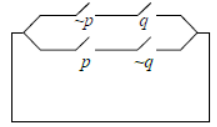
Answer
A
Question. For the circuits shown below, the Boolean polynomial is:
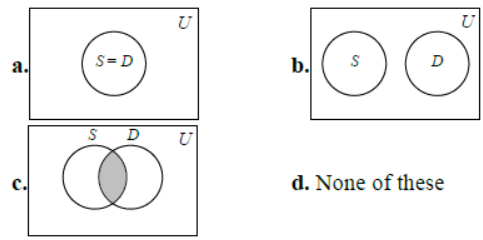
(a) (~ p ∨ q) ∨ ( p ∨ ~ q)
(b) (~ p ∧ p) ∧ (q ∧ q)
(c) (~ p ∧ ~ q) ∧ (q ∧ p)
(d) (~ p ∧ q) ∨ ( p ∧ ~ q)
Answer
D
Question. Let p be the proposition : Mathematics is a interesting and let q be the propositions that Mathematics is difficult, then the symbol p ∧ q means:
(a) Mathematics is interesting implies that Mathematics is difficult
(b) Mathematics is interesting implies and is implied by Mathematics is difficult
(c) Mathematics is interesting and Mathematics is difficult
(d) Mathematics is interesting or Mathematics is difficult
Answer
C
Question. An AND gate is the Boolean function defined by:
(a) f (x1 , x2 ) = x1 😡2 , x1 , x2 ∈{0,1}
(b) f (x1 , x2 ) = x1 +x2 , x1 , x2 ∈{0,1}
(c) f (x1 , x2 ) = x1 , x1 , x2 ∈{0,1}
(d) f (x1 , x2 ) = x2 , x1 , x2 ∈{0,1}
Answer
A
Question. If p and q are simple propositions, then p⇒ q is false when:
(a) p is true and q is true
(b) p is false and q is true
(c) p is true and q is false
(d) Both p and q are false
Answer
C
Question. The combination of ‘NAND’ gates shown here under (figure) are equivalent to:
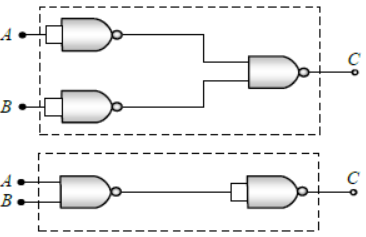
(a) An OR gate and an AND gate respectively
(b) An AND gate and a NOT gate respectively
(c) An AND gate and an OR gate respectively
(d) An OR gate and a NOT gate respectively.
Answer
B
Question. For the given combination of gates, if the logic states of inputs A, B, C are as follows A = B = C = 0 and A = B = 1, C = 0 then the logic states of output D are:

(a) 0, 0
(b) 0, 1
(c) 1, 0
(d) 1, 1
Answer
D
Question. Which of the following gates will have an output of 1?

Answer
C
Question. Which represents NAND gate?

Answer
A
Question. The given truth table is of:
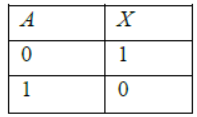
(a) OR gate
(b) AND gate
(c) NOT gate
(d) None of above
Answer
C
Question. To get an output 1 from the circuit shown in the figure, the input must be:
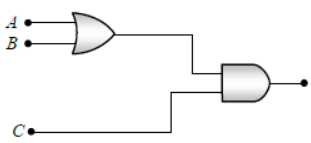
(a) A = 0, B = 1, C = 0
(b) A = 1, B = 0, C = 0
(c) A = 1, B = 0, C = 1
(d) A = 1, B = 1, C = 0
Answer
C
Question. The combination of the gates shown in the figure below produces:
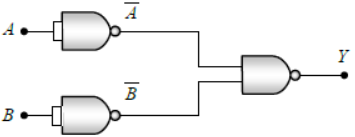
(a) NOR gate
(b) OR gate
(c) AND gate
(d) XOR gate
Answer
B
Question. Which of the following is a logical statement?
(a) Open the door
(b) What a beautiful girl!
(c) Are you going to Delhi?
(d) All prime numbers are odd numbers.
Answer
D
Question. Which of the following is not a logical statement?
(a) 8 is less than 6
(b) Every set is a finite set
(c) The sun is a star
(d) Kashmir is far from here.
Answer
D
Question. Which of the following is not a logical statement?
(a) Today is Monday
(b) There is no rain without clouds
(c) If the diagonals of a quadrilateral bisect each other then it is a parallelogram
(d) Square of a real number is always negative
Answer
A
Question. If p, q, r are simple propositions with truth values T, F, T, then the truth value of (~ p ∨ q) ∧ ~ r⇒ p is:
(a) True
(b) False
(c) True if r is false
(d) True if q is true
Answer
A
Question. If ( p ∧ ~ r)⇒(q ∨ r) is false and q and r are both false, then p is:
(a) True
(b) False
(c) May be true or false
(d) Data insufficient
Answer
A
Question. Which of the following is a statement?
(a) x is a real number
(b) Switch off the fan
(c) 6 is a natural number
(d) Let me go
Answer
C
Question. Which of the following is not a statement?
(a) Smoking is injurious to health
(b) 2 + 2 = 4
(c) 2 is the only even prime number
(d) Come here
Answer
D
Question. The connective in the statement “2 + 7 > 9 or 2 + 7 < 9,” is
(a) and
(b) or
(c) >
(d) <
Answer
B
Match the Column
Question. Match the statements in column I with those given in column II.

(a) A→ 1; B→ 2; C→ 3
(b) A→ 1; B→ 3; C→ 2
(c) A→ 3; B→ 1; C→ 2
(d) A→ 3; B→ 1; C→ 2
Answer
A
Question. Match the statements in column I with those given in column II..
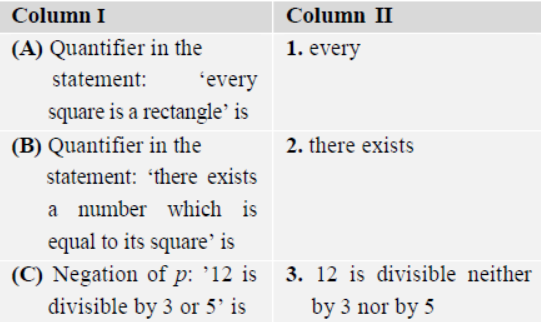
(a) A→ 1; B→ 2; C→ 3
(b) A→ 1; B→ 3; C→ 2
(c) A→ 3; B→ 1; C→ 2
(d) A→ 3; B→ 4; C→ 2
Answer
A
Question. Match the statements in column I with those given in column II.
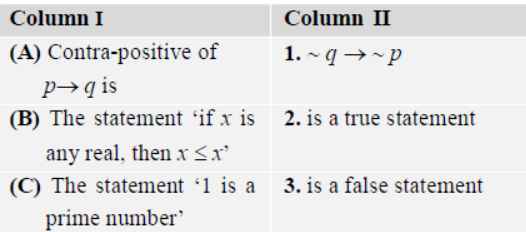
(a) A→ 1; B→ 3; C→ 4
(b) A→ 1; B→ 2; C→ 3
(c) A→ 3; B→ 1; C→ 2
(d) A→ 3; B→ 4; C→ 2
Answer
A